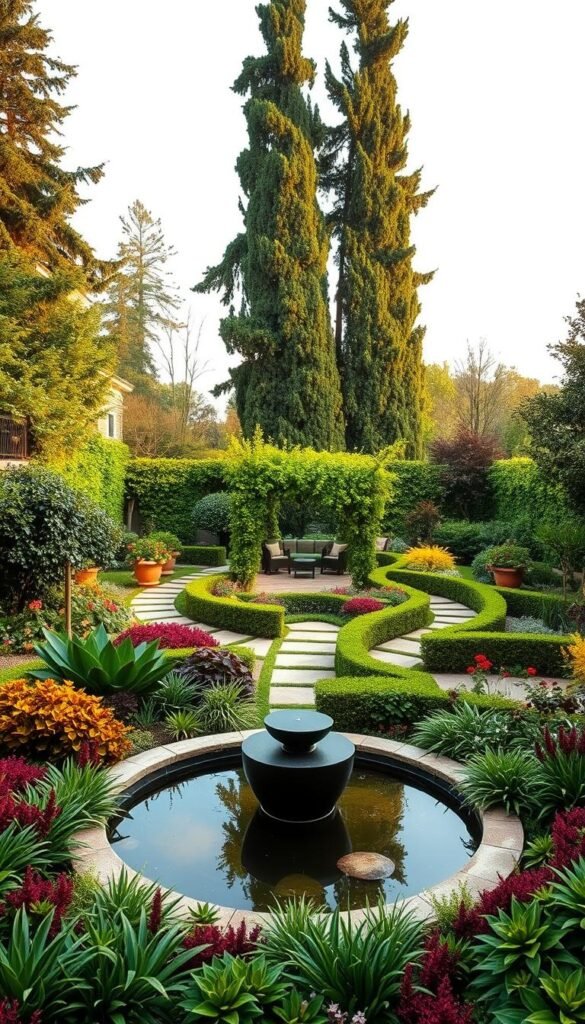Your yard is more than just grass and plants—it’s a canvas for self-expression. With smart planning, even modest areas can become inviting retreats. Scott McLeod of McLeod Landscaping Inc., who’s shaped properties for 30+ years, says “Great spaces mirror how you live, not just what looks good.”
This guide helps you craft areas that blend practicality with charm. Whether you want a quiet nook for morning coffee or a lively zone for gatherings, smart choices matter. Think pergolas for shade, firepits for warmth, or native blooms that buzz with pollinators.
You’ll learn how placement and structure turn dreams into reality. Small tweaks—like grouping plants by water needs or adding stepping stones—can boost usability. The goal? A place that feels like your personal sanctuary, tailored to your routines and tastes.
Ready to reimagine your plot? Let’s explore how thoughtful design creates harmony between what you need and what inspires you.
Embracing Your Garden Dream: Setting the Stage
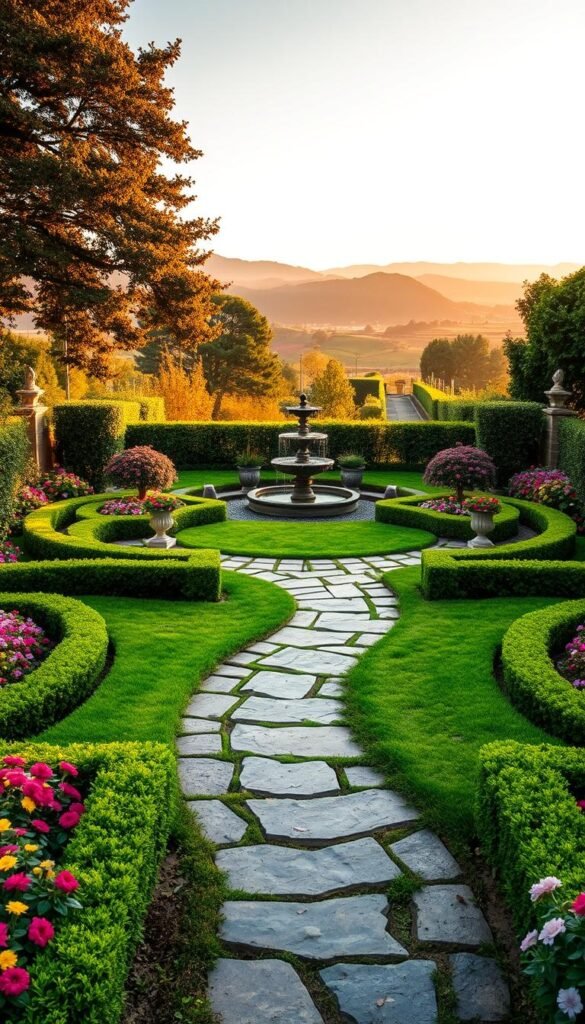
Your outdoor space holds stories waiting to unfold. For thousands of years, from Egyptian courtyards to medieval herb plots, gardens have shaped how we connect with nature. Today, your plot becomes a living diary where every plant choice whispers your story.
Understanding the Role of Design in Outdoor Spaces
Great design turns random greenery into purposeful areas. Think of symmetry like matching bookends—balanced shrubs framing a pathway. Proportion matters too: tall grasses behind low-growing thyme create visual rhythm. “Harmony happens when materials converse,” notes landscape historian Maria Sanchez, referencing stone patios blending with wooden arbors.
These principles help your space feel intentional. A well-placed bench under a maple tree becomes a reading nook. Native flowers near windows invite butterflies while reducing water use.
How Your Garden Can Reflect Your Personality
Do you love bold colors or muted earth tones? Rambling wildflowers or tidy hedges? Your plant picks and decor choices act like fingerprints. A modern minimalist might choose sculptural succulents in geometric pots, while a free spirit opts for cottage-style blooms spilling over walkways.
Blend indoor comforts outside by continuing your home’s color scheme. Love hosting? Create conversation zones with weather-resistant chairs around a fire bowl. Your garden becomes a natural extension of your living room—and your unique spirit.
Innovative Garden Layout Ideas That Balance Function and Style
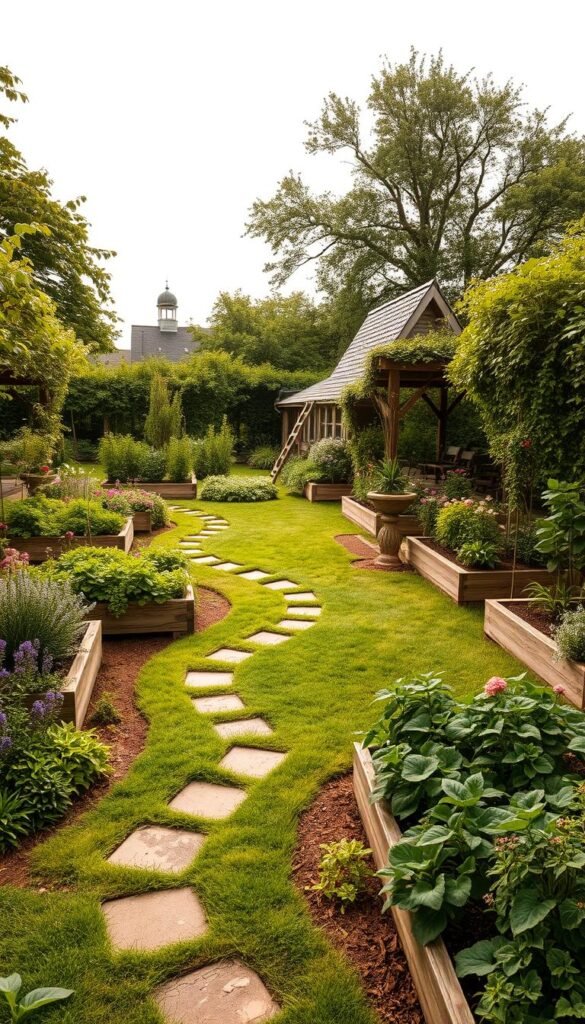
Transform your yard into a living masterpiece that serves multiple purposes. Curved walkways replace rigid lines, guiding visitors through fragrant lavender patches toward a central gathering spot. “Paths should whisper ‘follow me’ rather than shout directions,” explains McLeod Landscaping’s lead designer.
Strategic placement of features creates natural destinations. A pergola draped in wisteria becomes an open-air dining room, while tucked-away benches offer private reading corners. Consider these multi-use elements:
| Element | Function | Bonus Benefit |
|---|---|---|
| Raised planters | Define spaces | Easy-access herbs |
| Dry creek beds | Drainage solution | Visual interest |
| Modular seating | Flexible entertaining | Hidden storage |
Mix practical and pretty by blending flowering shrubs with edible varieties. Blueberry bushes double as colorful borders, while vertical trellises support both roses and beans. This approach maximizes every square foot without sacrificing beauty.
Fire features extend your outdoor season while creating focal points. Surround a modern fire bowl with swivel chairs for year-round use. For low-maintenance charm, group drought-tolerant sedums with ornamental grasses that sway in the breeze.
Planning Your Outdoor Space: Zones and Plant Grouping
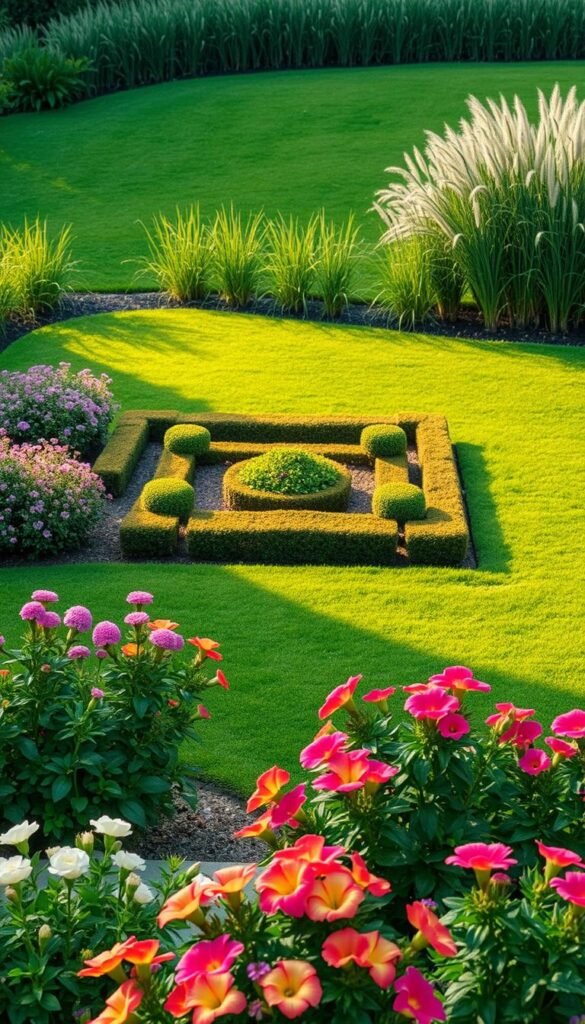
Smart zoning turns your outdoor area into a living tapestry where every plant plays a role. Grouping by height and purpose creates harmony between aesthetics and harvests. Let’s explore how to layer greenery for maximum impact.
Designing Functional Zones with Plant Heights
Start with tall growers like corn or sunflowers at your plot’s northern edge or center. This prevents shade from drowning sun-loving smaller varieties. Mid-sized stars like peppers thrive in middle zones with 6+ hours of sunlight.
| Plant Type | Placement | Key Benefit |
|---|---|---|
| Tomatoes/Corn | Back/Center | Sun blocking |
| Eggplants/Beans | Middle rows | Moderate light use |
| Lettuce/Herbs | Front edges | Easy picking |
Guiding Movement with Purposeful Planting
Weave pollinator magnets like lavender between vegetable rows. “Herbs like marjoram and chives act as both kitchen staples and pollinator magnets,” notes Sean McMenemy of Ark Wildlife. Add structural shrubs as natural walkway borders—boxwoods frame paths while dwarf fruit trees create overhead interest.
Cluster flowers like zinnias near seating areas to draw butterflies. This strategic placement creates invisible pathways that feel organic. Your space becomes a journey where each turn reveals new textures and scents.
Creative Enhancements to Elevate Your Garden’s Appeal
Small touches often create the biggest wow moments in outdoor spaces. Whether you’re refreshing an existing plot or starting fresh, clever accents bring life to every corner.
Blooms That Work Smarter
Mix perennial and annual flowers for year-round interest. Daylilies and lavender form a sturdy base, while marigolds add fiery summer pops. “Pairing long-lasting perennials with seasonal stars keeps beds lively,” suggests a landscape design expert.
| Plant Type | Color Range | Care Level |
|---|---|---|
| Lavender | Purple/White | Low |
| Zinnias | Rainbow | Moderate |
| Nasturtiums | Orange/Yellow | Easy |
Group plants with similar water needs near walkways. This creates tidy clusters that simplify watering routines.
Artful Touches With Purpose
Decorative pots do double duty—they showcase herbs and add height variations. Try stacking colorful containers with trailing strawberries or compact peppers.
Edible flowers like pansies jazz up salads while brightening beds. A ceramic birdbath becomes both sculpture and wildlife hub. These elements merge beauty with practicality, making your space uniquely yours.
2024 Garden Design Trends: Modern, Sustainable, and Vertical Solutions
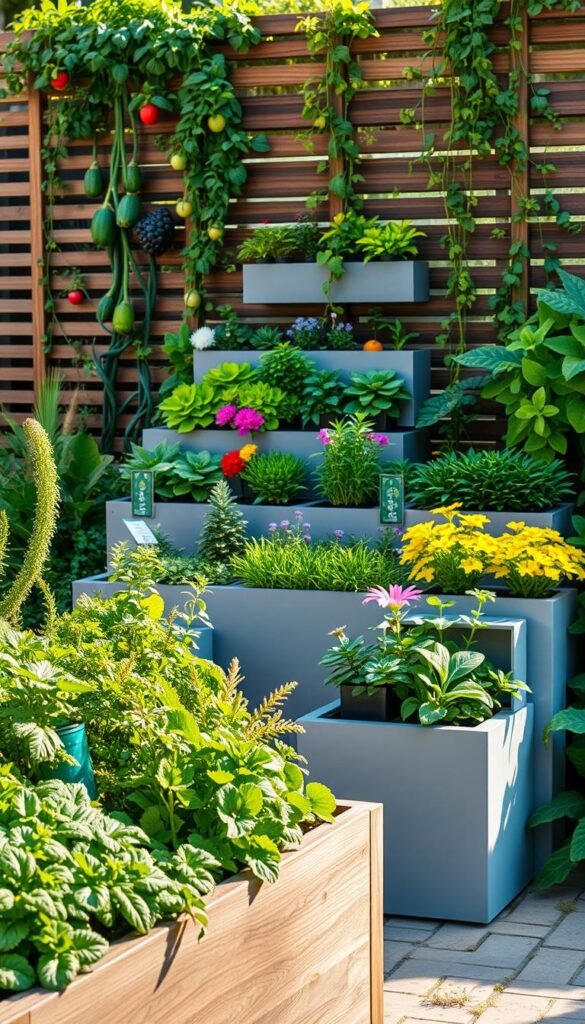
This year’s outdoor trends blend eco-conscious choices with clever space hacks. You’ll find smart solutions that nurture both your plot and local ecosystems while fitting modern lifestyles.
Eco-Friendly Options and Native Planting Strategies
Native species like milkweed and coneflowers thrive with minimal fuss. They’re drought-resistant and support butterflies, bees, and birds. “Local plants build healthier food webs,” says urban ecologist Dr. Lena Torres.
| Native Plant | Water Needs | Wildlife Benefit |
|---|---|---|
| Black-eyed Susan | Low | Attracts goldfinches |
| Switchgrass | Moderate | Shelters small mammals |
| Bee balm | Medium | Feeds hummingbirds |
Recycled materials shine in 2024 designs. Try crushed concrete paths or repurposed pallet planters. Rain barrels paired with drip irrigation cut water bills by up to 50%.
Vertical Gardening and Smart Landscape Tools
Turn blank walls into lush tapestries with pocket planters or trellis systems. Strawberries and cherry tomatoes grow well vertically, freeing ground space for seating areas.
| Vertical System | Best For | Space Saved |
|---|---|---|
| Modular panels | Herbs & succulents | 4 sq ft per panel |
| Hanging gutters | Leafy greens | Up to 75% |
| Tiered planters | Flowering annuals | 3x yield vs ground |
Smart tech simplifies care. Soil sensors send moisture alerts to your phone, while solar lights with timers create ambiance. These tools help you grow more with less effort—perfect for busy plant lovers.
Maximizing Small Spaces with Ingenious Layouts
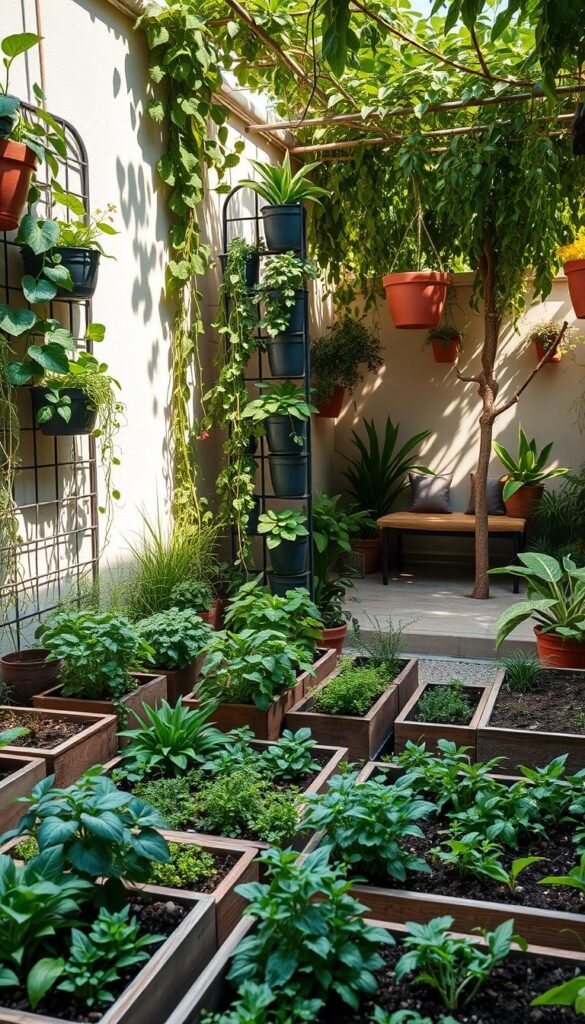
Limited square footage doesn’t mean limited potential—your compact outdoor area can burst with life through smart design choices. By layering heights and rethinking vertical surfaces, you’ll create depth that tricks the eye into seeing expansiveness.
Utilizing Container Gardening and Tiered Designs
Pots and planters unlock flexibility in tight spots. Try stacking containers with trailing ivy up top and basil below. This vertical approach triples growing space while adding sculptural interest.
Three-tiered stands turn patios into herb havens. Place mint on the bottom (it spreads fast), thyme in the middle, and annual flowers up top. Rotate pots seasonally—swap pansies for peppers when temperatures rise.
Narrow Border Techniques and Creative Space Dividers
Transform skinny side yards with 18-inch-deep raised beds. Plant columnar apple trees against fences, underplanted with shade-tolerant hostas. Bamboo screens wrapped in clematis vines section off seating nooks without blocking light.
Use color gradients to stretch visual space. Position purple salvias at the back, pink begonias mid-level, and white alyssum along edges. This layering effect makes 6-foot-wide plots feel like sprawling gardens.
Incorporating Smart Design Tools for Landscape Success
Modern technology turns planning from a chore into a creative adventure. Free digital platforms like Plan-a-Garden let you arrange plants, trees, and structures with fingertip precision. These tools help visualize your vision before buying a single shrub—saving money and preventing costly mistakes.
Mastering Drag-and-Drop Simplicity
The intuitive interface works like your favorite photo editor. Drag a maple tree to your property’s north edge or cluster roses by the patio. Experiment with spacing for mature growth—see how that young oak will cast shade in five years.
Seasonal previews reveal your garden’s changing looks. Will spring bulbs clash with summer lilies? The tool shows you. Built-in lists track needed materials, while maintenance reminders keep projects on schedule.
Whether designing a cottage-style flower bed or modern succulent display, these features make landscaping accessible. Your dream space becomes a tap-and-swipe project—no degree required.

